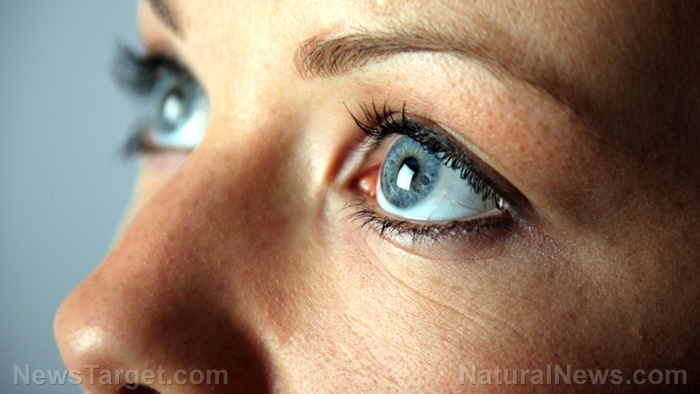11 Foods proven to lower glaucoma risk
01/17/2024 / By News Editors

Glaucoma leads to incurable blindness. There are no early warning signs. Half of people with the disease don’t even know they have it. Changing your diet can cut your risk.
(Article republished from GreenMedinfo.com)
Glaucoma is the second leading cause of blindness in the world after cataracts. It’s a neurological disorder that leads to deterioration of the optic nerve which connects your eyes to your brain. Eventually it leads to irreversible blindness.
It’s estimated that 60 million people in the world and three million in the U.S. have glaucoma. But only half of those with the condition know they have it. The cause is not known and there are no early warning signs or symptoms.
High risk groups include people over 60, those with a family history, diabetics, and people who are severely nearsighted. Having light colored eyes is another risk factor. Blue or gray eyes are more likely to suffer damage compared to green or hazel. The least risky eye color is brown.[i]
One major risk factor is an increase in intraocular pressure (IOP). Another is poor regulation of blood flow to the optic nerve. Oxidative damage may also contribute to the condition.
There is no cure for glaucoma. Drug treatments focus on lowering pressure in the eye. But that won’t always prevent further progression of the condition.
Newer research shows various natural substances may prove useful in treating glaucoma. Studies focus on natural ways to relieve IOP, improve blood flow to the eye, and reduce oxidative stress. And the results show that improving your diet can reduce your risk of developing glaucoma.
Eating more fresh fruits and vegetables high in vitamins A and C is linked to a lower risk. So are foods high in carotenoids.
An NIH study published in the American Journal of Ophthalmology found that women who ate 3 or more servings per day of all fruits and fruit juices reduced their odds of having glaucoma by 79 percent compared to those who consumed less than 1 serving per day.
People getting the highest levels of vitamin C slashed their risk by 70 percent. High intakes of vitamin A cut risk by 63 percent, and alpha-carotene by 54 percent.[ii]
But not all fruits and vegetables give you the protection. Here are 11 foods proven to reduce your risk of glaucoma.
1. and 2. Kale and Collard Greens
The NIH study found that eating three or more servings of vegetables per day didn’t have any effect on glaucoma rates. But certain vegetables told an entirely different story.
Eating one serving of kale or collard greens per week could cut your risk of glaucoma by 57 percent.[iii]
A recent study from the Harvard School of Public Health suggests that the glaucoma-fighting power of leafy greens may be found in their high nitrate levels. Nitrates from greens are a precursor for nitric oxide which promotes healthy blood circulation.
The Harvard researchers followed participants in the Nurses’ Health Study (63,893 women; 1984-2012) and the Health Professionals Follow-up Study (41,094 men; 1986-2012). They found getting more nitrates and leafy greens in your diet was linked to a 20 percent to 30 percent lower glaucoma risk. The link was even stronger for a type of glaucoma linked to poor blood flow. In those cases nitrates cut risk by 40 to 50 percent.[iv]
3. and 4. Oranges and Peaches
Women in the NIH study who consumed more than two servings per week of fresh oranges or peaches cut their odds of getting glaucoma. The women who ate oranges cut their risk by 82 percent while eating more peaches cut risk by 70 percent.
Eating the whole fresh fruit made a big difference. Orange juice did not give the same benefits even for people who drank it every day. And while fresh peaches were protective, canned peaches were not.
5. Wild-Caught Salmon
In a study of glaucoma patients and their healthy siblings, British researchers found that glaucoma patients had lower levels of eicosapentaenoic (EPA), and docosahexaenoic (DHA) fatty acids and total omega-3 long-chain polyunsaturated fatty acids. The researchers suggested that EPA and DHA could modulate impaired systemic microcirculation and ocular blood flow and optic neuropathy, which are the associated with glaucoma.[v]
In addition to wild-caught salmon, other good sources of EPA and DHA include fatty cold-water fish like sardines, mackerel, herring, and tuna.
6., 7., and 8. Green Tea, Cocoa, and Red Wine
A new meta-analysis study showed that flavonoids have a promising role in improving vision in patients with glaucoma and high eye pressure. They appear to play a part in improving and slowing the progression of visual field loss.[vi]
Flavonoids are polyphenol compounds found in plants. The most common flavonoid-rich foods are green tea, red wine and cocoa. They’ve been found to have neuroprotective and antioxidant powers that appear to benefit glaucoma patients.
A randomized, placebo-controlled, double-masked 24-month trial revealed that black currant anthocyanins slowed down the visual field deterioration. Researchers believe the black currants help normalize blood flow in the eye.
10. Goji Berries
High intraocular pressure leads to the loss of vision by destroying retinal ganglion cells (RGCs) in the retina. A recent animal study showed the medicinal herb Lycium barbarum L., better known as the goji plant, stopped the loss of RGCs and the neurodegeneration in the retina found in glaucoma. The benefits were independent of eye pressure.[vii] In other words, the goji promoted RGC survival in spite of elevated eye pressure. Animals fed a goji extract nearly totally escaped from pressure-induced loss of RGCs.
11. Eggplant
Researchers studied male volunteers who were asked to eat 10 grams of Solanum melongena L. (eggplant). Results showed the eggplant reduced intraocular pressure by 25 percent. The writers suggested that eggplant would be of benefit to patients suffering from glaucoma.
Read more at: GreenMedinfo.com
Submit a correction >>
Tagged Under:
alternative medicine, eye health, food cures, food is medicine, food science, fruits, glaucoma, health science, natural cures, natural health, natural medicine, naturopathy, nutrients, nutrition, organics, prevention, remedies, veggie
This article may contain statements that reflect the opinion of the author
RECENT NEWS & ARTICLES
consumerwellness.info is a fact-based public education website published by consumerwellness.info
All content copyright © 2023 by consumerwellness.info
Contact Us with Tips or Corrections
All trademarks, registered trademarks and servicemarks mentioned on this site are the property of their respective owners.




















